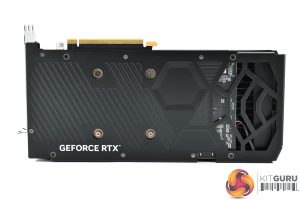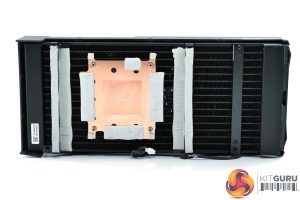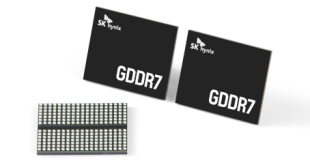As we pulled this RTX 4090 from Acer's Predator Orion X prebuilt system, we don't have the usual box or accessories to go over – instead we can take an immediate look at the card itself. The design is generally pretty low-key, using a matte black shroud that is made from plastic. There's a small Acer Predator logo printed in grey that sits between the two fans, but otherwise the shroud is fairly plain. It does feature RGB LEDs, but these are only controllable using the PredatorSense software on the Orion X system itself – so I couldn't configure them on my own PC.
As for the two fans, these measure 100mm in diameter and after disassembling the cooler, we found that Acer is using Ecotherm GFY10015H12BPA dual ball-bearing fans.
It's a relatively compact card, too – at least as far as RTX 4090s go. We don't have official dimensions but, as you can see in our video, Acer's RTX 4090 is a couple of centimetres shorter than Nvidia's Founders Edition, a similar height but still three slots thick. Acer’s model is a touch lighter though, coming in at 1.8KG, compared to almost 2.2KG for the Founders.
Over on the front side, the shroud here is a grey plastic and houses the GeForce RTX logo. The backplate is made from black metal, and it does feature a few cut-outs to allow air to pass directly through the heatsink. There's no dual-BIOS switch on the card however.
Power is supplied by a single 12VHPWR connector, while display outputs are entirely standard, with 3x DP 1.4 and 1x HDMI 2.1.
As for the PCB, this looks similar to reference RTX 4090 designs, but it's just a bit longer with more custom componentry at the end of the PCB for the card's RGB lighting. It's not a particularly high-end design, comprising just 14 phases for the GPU, using 55A Alpha and Omega AOZ5311NQI MOSFETs and controlled by a UPI uP9512U. The memory VRM is 4-phase, again using the same 55A Alpha and Omega MOSFETs, but with via a UPI uP9512R controller.
The cooler is arguably the most interesting thing about the whole card, as it's actually using liquid cooling, via a pump and radiator that sit within the shroud itself. The GPU and memory contact a copper baseplate, with the liquid flowing beneath that contact plate and then through the radiator. The pump is built into the radiator, on the right hand side (when look at the image above). The radiator itself measures approximately 270mm long, 116mm tall and is 29mm thick.
Four smaller contact plates are used to cool the MOSFETs. There's no thermal pads on the back of the PCB however, so the metal backplate is not being used as a heatspreader, something which can make a small difference to memory thermals.
 KitGuru KitGuru.net – Tech News | Hardware News | Hardware Reviews | IOS | Mobile | Gaming | Graphics Cards
KitGuru KitGuru.net – Tech News | Hardware News | Hardware Reviews | IOS | Mobile | Gaming | Graphics Cards














